Chapter 19
Ten Teams Apps Worth Discovering
IN THIS CHAPTER
![]() Understanding what apps are available for Teams
Understanding what apps are available for Teams
![]() Discovering apps for design, development, productivity, and customer service
Discovering apps for design, development, productivity, and customer service
![]() Finding out about apps for marketing and education
Finding out about apps for marketing and education
I use many different Microsoft Teams apps on a daily basis. I use apps for everything from design, development, productivity, and customer service to social media, surveys, and marketing. There are even apps specifically designed for industry-specific needs such as education.
In this chapter, I highlight ten useful apps for Teams that you may want to check out, too. There are many, many apps in specific categories that could be listed here; however, I spread my picks across different areas to provide you with a good understanding of what Teams can do when you extend it with apps.
Microsoft Office
It makes sense that Microsoft Teams works well with the other Microsoft Office products. You will find tight integration with apps for Word, Excel, PowerPoint, and OneNote (https://products.office.com/en-us/microsoft-teams). These apps often come preconfigured, and you can add them to teams and channels and customize how you use them within Teams in general. Figure 19-1 shows the Excel app rendering a spreadsheet within Teams.

FIGURE 19-1: The Excel app for Teams rendering a spreadsheet.
Another set of useful Microsoft Office apps for Teams are Flow and SharePoint. Microsoft Flow is used to build workflows between the different Office products. Microsoft SharePoint is a content management platform. Both are available with Microsoft 365 depending on your license.
I find it incredibly useful to build flows that interact with Teams. For example, I like to use Microsoft Flow to add notifications to my Teams channels when something happens in SharePoint that needs my team’s attention (such as an approval).
To learn more about Microsoft Flow, take a look at Microsoft Office 365 For Dummies (Wiley), where it is covered in more detail. And to learn more about Microsoft SharePoint, check out Microsoft SharePoint For Dummies (Wiley), which tells you everything you need to know about getting up and running with SharePoint.
Task Management
If you work with a team, you most likely use some type of task management product. All the top products have apps available for Teams. You will find apps for Asana, Azure DevOps, Jira, Microsoft Project, Trello, and many others.
Most of these apps introduce notifications in the form of a bot. Using the bot app, you can interact with tasks in the relevant task management system. I find these apps really improve productivity because I don’t have to jump out of Teams in order to mark a task as complete or create a new task. Figure 19-2 shows the Trello app (https://trello.com) being used in a channel in Teams.
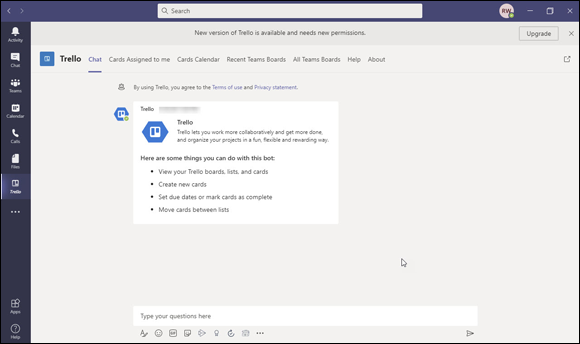
FIGURE 19-2: The Trello app for Teams.
Design
Microsoft Teams embraces digital designers with several apps that integrate with the most popular digital design services. You will find apps for such popular collaborative design services such as Marvel App (https://marvelapp.com) and Freehand by InVision (www.invisionapp.com/feature/freehand).
One of my personal favorites is the Adobe Creative Cloud (CC) app for Teams (www.adobe.com/creativecloud.html). The app lets you access your Adobe Creative Cloud assets from within Microsoft Teams. It supports all the main file types, such as PSD, AI, INDD, and the new XD type from Adobe XD CC. Figure 19-3 shows using the Adobe Creative Cloud app in a Teams chat.
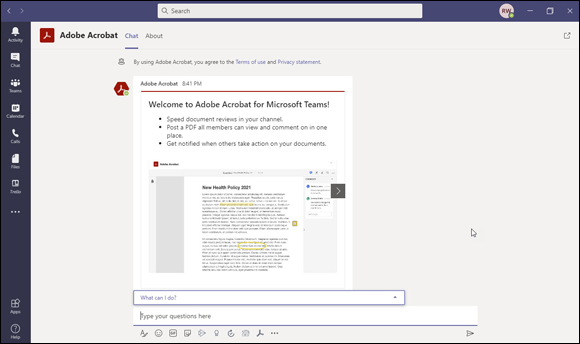
FIGURE 19-3: The Adobe Creative Cloud app in a Microsoft Teams chat.
Customer Service
Keeping customers happy is critical for any organization, and Microsoft Teams has apps that integrate with many customer service products. A few of my favorites include Intercom, Zendesk, and zoom.ai.
Using these apps, you can add tickets from within a Teams channel, view existing tickets, and update tickets based on customer interactions. Figure 19-4 shows the Zendesk (https://www.zendesk.com/microsoft-teams) page that walks through setting up the Microsoft Teams app. The page is entitled “Microsoft: Setting up the Microsoft Teams — Zendesk Support Integration.” You can find it using your favorite search engine.
The process of installing an app is generally easy and straightforward. You install the app and then authenticate it to work with the relevant service. If the app needs permissions in Teams, it will ask for them when you install it.

FIGURE 19-4: The setup page for the Zendesk app for Teams integration.
Development
Software development has taken on an entirely new meaning in the modern era. Developing software solutions isn’t just about writing code anymore. Being a developer means building something using tools, and often those tools can be integrated with apps in Teams. For example, the development platform GitHub (https://github.com) is used for developing content as well as websites. I am not a developer, but I find myself working extensively with GitHub these days. Other clients I work with use Azure DevOps (https://azure.microsoft.com) and yet others use PowerApps (https://powerapps.microsoft.com) to build mobile solutions.
Using the GitHub app in Teams you can:
- View information about pull requests
- Write comments in issues and pull requests
- Create, read, update, close, and re-open Issues
- Add notifications to Teams channels based on changes made in GitHub
- Work with your subscriptions to repositories
- View repositories available
- Search through issues and pull requests and view results in channels
Education
Education is a unique industry that spans teaching tiny tots how to use silverware all the way to world-renowned researchers collaborating about the latest breakthroughs in artificial intelligence. One critical aspect to ensure success in any level of study is communication. Parents need to communicate with teachers; students need to communicate with each other and with their teachers; and researchers need to collaborate and communicate with the broader community. Several Teams apps are designed specifically for education. EdCast, FlipGrid, and Haldor Ed are some services that I have used and recommend.
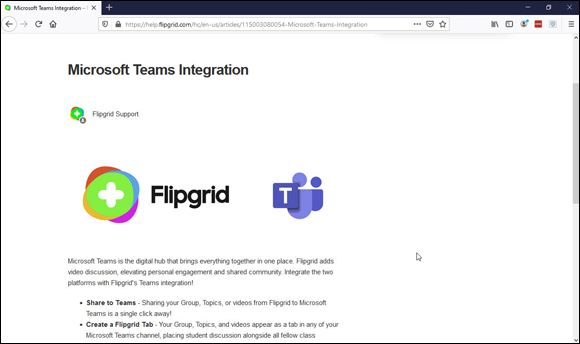
FIGURE 19-5: The FlipGrid Help page explaining its app integration with Teams.
Social Media
Social media provides a mechanism for organizations to connect directly with its customers. Today, it is common for customers to use social media to interact with each other and discuss organizations and products.
You will find two types of social media apps for Teams. There are apps for the social media platforms themselves, such as Facebook, Twitter, and LinkedIn. And there are tools used to help organizations manage their presence on these platforms, such as Sociabble (www.sociabble.com/microsoft-office-365).
One app I find particularly useful is the Twitter app. Using this app, you can keep track of tweets and hashtags you are following and have them delivered directly into the Teams channel for the appropriate teams.
Survey
It is always a good idea to get a feel for what people are thinking. Several apps for Teams enable you to use and send surveys to people within and outside of your organization. One of my favorites is built right into Microsoft 365 and is known as Forms. Another popular survey service is called Survey Monkey. There are Teams apps available for both.
Marketing
Most organizations need to think about marketing, and there are many marketing-related services and products to choose from. Most of the top marketing products provide a Teams app for integration. A few of my favorites include Constant Contact, Google Analytics Insights, and MailChimp. Figure 19-6 shows adding the Google Analytics Insights app (https://marketingplatform.google.com) to a team. Once added, you can have Google send reports and metrics directly to your Teams channel.

FIGURE 19-6: The Google Analytics Insights app in Teams.
Miscellaneous
Two additional apps for Teams that I find incredibly useful are Power BI and Stream. Both are Microsoft services that integrate well with Teams. Microsoft Power BI (https://powerbi.microsoft.com) is a data analytics service (see Figure 19-7). Using Power BI, you can pull in data from just about any source you can imagine (databases, Excel spreadsheets, web services, and so on) and then build reports with the data using the Power BI tool. You can also set the data that Power BI pulls into the service to refresh on a set schedule. For example, you could set Power BI to run every hour and pull sales data from one database, marketing data from another database, and customer service data from some other web service. All of these separate sources of data could be combined into a single report that is refreshed hourly. Power BI is a powerful tool, and it integrates closely with SharePoint.
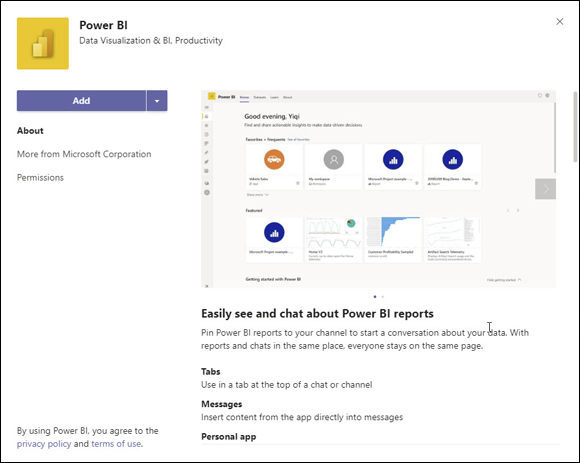
FIGURE 19-7: The product page for Microsoft Power BI.
Microsoft Stream (https://products.office.com) is a video-streaming service that you can use to upload, share, and view videos. It is built into Teams and you can use it to embed videos. You will find it as an option when you add a tab to a channel, as shown in Figure 19-8.
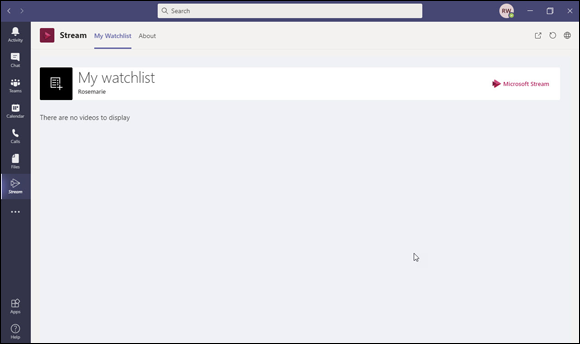
FIGURE 19-8: Adding Stream as a tab on a channel in Teams.
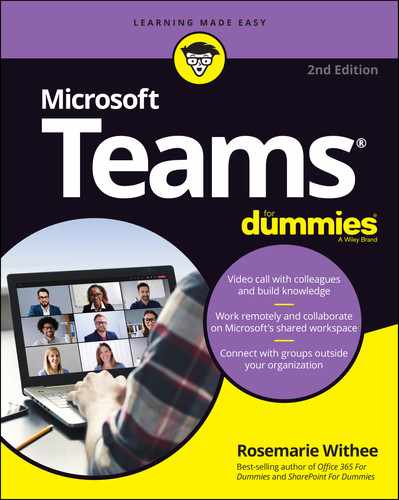
 Once you find apps you like, check out
Once you find apps you like, check out  A new Microsoft product called Planner (
A new Microsoft product called Planner (